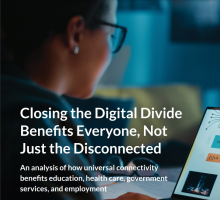As digital equity advocates push Congress to replenish the rapidly diminishing funds that support the Affordable Connectivity Program (ACP), a recently published report should help bolster the case that the program – which subsidizes the cost of monthly Internet service for income-eligible households – won’t just help more Americans get broadband access, it can also incent Internet service providers (ISPs) to make infrastructure investments in unserved and underserved areas.
The report, titled "Closing the Digital Divide Benefits Everyone, Not Just the Disconnected" – published by Common Sense and the Boston Consulting Group (BCG) – emphasizes the benefits of universal Internet access across education, health care, government services, and employment. It makes the case that universal connectivity would allow institutions to “integrate Internet-based technologies into their services, improving them for the benefit of all.”
Most notably, the report advocates for increased ACP enrollment, arguing that in addition to providing low-income households some short-term relief from pricey Internet bills, the program can provide an economic incentive for ISPs to invest in unserved and underserved communities by increasing the return on investment (ROI) in areas that have previously been considered unprofitable.
The referenced media source is missing and needs to be re-embedded.
The Affordable Connectivity Program has been considered by some to be a “coupon” solution to the broadband affordability problem, and ILSR has long believed that while the ACP is critical to ensuring low-income customers can afford Internet access right now, more structural solutions are needed to make connectivity affordable to everyone over the long term.



